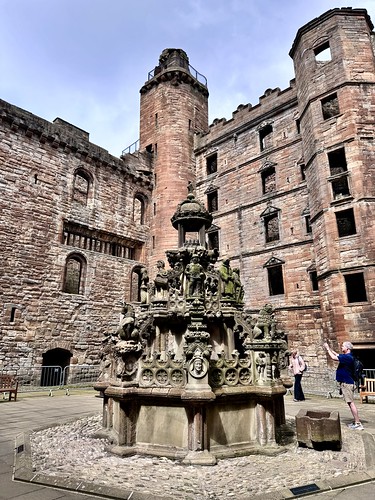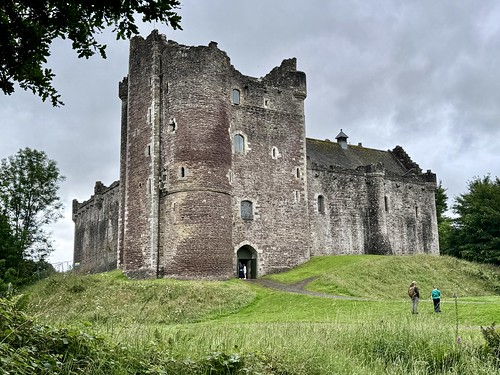July 18, 2024 -- I'm a big fan of Outlander, so booking a one-day Outlander Tour (in Scotland) was a no-brainer for me. It was a small group tour with a company called Rabbie. It left from the Edinburgh bus station. Our tour guide was a young man named Jamie. Believe it or not. He claimed it was his real name, not a stage name. Jamie had only been with the tour company for a few weeks. He did a good job, giving us a lot of information and playing Scottish music in between (I think he was a wanna-be DJ). I gave him a good tip.
Our first stop was Midhope Castle, a 15th century tower house. In the series, it stands in for Lallybroch (Broch Tuarach), the ancestral home of Jamie Fraser. The interior of the castle is closed to the public. It is derelict. All the interior shots were filmed in a studio. I have to admit that standing in front of Lallybroch was one of those "pinch me" moments. If only Jamie (Sam) had been there.
Me at Lallybroch
Lallybroch (Midhope Castle)
 Mailbox for Jamie and Claire Fraser
Mailbox for Jamie and Claire FraserOur next stop was Blackness Castle, Fort William in the series. Fort William is where Jamie received his lashes from Captain Randle. It is also where Jamie's father died after seeing his son punished. Jamie rescued Claire from Fort William when she was being held by Jack Randle. During filming, the metal railing was replaced with 18th century wooden railing.
In reality, Blackness Castle is one of Scotland's most impressive strongholds. It dates to the 15th century and is built on the southern shore of the Firth of Forth. The castle is shaped like a ship and is often called "the ship that never sailed." Blackness Castle fell to Oliver Cromwell's army in 1650. Some years after the siege, the castle was repaired and used as as a garrison and prison. Barracks and officers' quarters were added in the 1870's, when the castle was used as an ammunition depot until 1912.
 The ship that never sailed.
The ship that never sailed. Blackness Castle, a.k.a. Fort William
Blackness Castle, a.k.a. Fort WilliamLinlithgow Palace was featured in season 1 of Outlander. It stood in for Wentworth Prison. It is where Jamie suffered his terrible ordeal at the hands of Black Jack Randle. The corridors and entrances were used in the filming.
 Linlithgow Palace, a.k.a. Wentworth Prison
Linlithgow Palace, a.k.a. Wentworth PrisonLooking out to Linlithgow Loch
Known as "King's Fountain," the ornate fountain in the courtyard of Linlithgow Palace was built in 1538 by King James V, who wanted to show Henry VIII that the Scottish Monarchy was as grand and powerful as other monarchies in Europe. The fountain stands over 16 feet high and is a masterpiece of stone masonry. When Bonnie Prince Charlie visited Linlithgow in 1745, the fountain was made to flow with wine. The fountain was restored to working order in 2006, and on select days has water flowing through it.
 The King's Fountain
The King's Fountain
Linlithgow Palace was one of the principle residences of the Scottish Monarchy in the 16th and 17th centuries. It was a place for them to escape the stresses of the city. It is the birthplace of many Scottish monarchs, including Mary, Queen of Scots. According to signs at the palace, Prince Charles is a direct descendent of Mary, Queen of Scots. He was born 14th generations after her. Unfortunately, Linlithgow Palace was burned in 1746. Today, it is just a shell of its former self. But, it was still fun to explore. There were so many rooms and floors, along with a magnificent fountain in the courtyard.
 Statue of Mary, Queen of Scots
Statue of Mary, Queen of Scots
Castle Leoch is the fictional seat of Clan MacKenzie. In the series, Doune Castle served as Castle Leoch. Much of the castle was used in filming. An interesting exception was the kitchen, which was replicated in a studio. There was a guided tour of the castle, with headsets. At some of the stops, Sam Heughan, the actor who portrays Jamie, did the speaking.
In reality, Doune Castle is a medieval stronghold on the fringe of the Scottish Highlands. It occupied a strategic site, being at the geographic center of Scotland, only 5 miles from Stirling Castle, "the crossroads of Scotland." During the Jacobite Rebellion of 1754, the castle was occupied by Bonnie Prince Charlie and his Jacobite Highlanders. The castle was originally built in the 13th century, rebuilt in the 14th century, and restored in the 1880s.
 Doune Castle, a.k.a. Castle Leoch
Doune Castle, a.k.a. Castle Leoch The courtyard
The courtyard Me at Castle Leoch
Me at Castle Leoch
There are many films besides Outlander that have filmed at Doune Castle, including Outlaw King, a historical movie about Robert the Bruce.
Our last stop of the day was the lovely 18th century village of Culross (in Fife). Culross has been featured in many episodes of Outlander. It served as Crainsmuir, a fictional village in the Scottish Highlands. It was the home of Geillis Duncan. Culross Palace provided many locations for filming. Both the interior and exterior of the palace have been used for filming.
Culross, a.k.a. Crainsmuir
 Claire's herb garden
Claire's herb garden
Culross is one of Scotland's best preserved and most picturesque villages. Visiting it is like traveling back in time. It has colorful buildings, cobblestone streets, red tiled roofs, and many examples of 16th and 17th century Scottish architecture.
 Whitewashed buildings
Whitewashed buildings The big stones are for important people to walk.
The big stones are for important people to walk.Culross Palace
Geillis's house (L) and the Mercat Cross
The Culross Townhouse has been standing since the 17th century. It was once a tolbooth. It is now a gift shop and exhibition space for the National Trust. Women accused of witchcraft were held in the Townhouse before their trials and executions. In Outlander, Geillis is sentenced to burn for being a witch.

Culross Townhouse
I have a different experience now when I watch Outlander. There is a familiarity.

























No comments:
Post a Comment